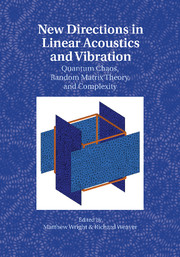Book contents
- Frontmatter
- Contents
- Foreword by Michael Berry
- Introduction
- 1 The Semiclassical Trace Formula
- 2 Wave Chaos for the Helmholtz Equation
- 3 The Unreasonable Effectiveness of Random Matrix Theory for the Vibrations and Acoustics of Complex Structures
- 4 Gaussian Random Wavefields and the Ergodic Mode Hypothesis
- 5 Short Periodic Orbit Theory of Eigenfunctions
- 6 Chaotic Wave Scattering
- 7 Transfer Operators Applied to Elastic Plate Vibrations
- 8 Mesoscopics in Acoustics
- 9 Diagrammatic Methods in Multiple Scattering
- 10 Time-Reversed Waves in Complex Media
- 11 Ocean Acoustics: A Novel Laboratory for Wave Chaos
- 12 Mesoscopic Seismic Waves
- 13 Random Matrices in Structural Acoustics
- 14 The Analysis of Random Built-Up Engineering Systems
- References
- Index
11 - Ocean Acoustics: A Novel Laboratory for Wave Chaos
Published online by Cambridge University Press: 05 October 2010
- Frontmatter
- Contents
- Foreword by Michael Berry
- Introduction
- 1 The Semiclassical Trace Formula
- 2 Wave Chaos for the Helmholtz Equation
- 3 The Unreasonable Effectiveness of Random Matrix Theory for the Vibrations and Acoustics of Complex Structures
- 4 Gaussian Random Wavefields and the Ergodic Mode Hypothesis
- 5 Short Periodic Orbit Theory of Eigenfunctions
- 6 Chaotic Wave Scattering
- 7 Transfer Operators Applied to Elastic Plate Vibrations
- 8 Mesoscopics in Acoustics
- 9 Diagrammatic Methods in Multiple Scattering
- 10 Time-Reversed Waves in Complex Media
- 11 Ocean Acoustics: A Novel Laboratory for Wave Chaos
- 12 Mesoscopic Seismic Waves
- 13 Random Matrices in Structural Acoustics
- 14 The Analysis of Random Built-Up Engineering Systems
- References
- Index
Summary
One of the fascinating aspects of the field known colloquially as quantum chaos is the immense variety of physical contexts in which it appears. In the late 1980s it was recognized that ocean acoustics was one such context. It was discovered that the internal state of the ocean leads to multiple scattering of sound as it propagates and leads to an underlying ray dynamics which is predominantly unstable, that is, chaotic. This development helped motivate a resurgence of interest in extending dynamical systems theory suitably for applying ray theory in its full form to a “chaotic” wave mechanical propagation problem. A number of theoretical tools are indispensable, including semiclassical methods, action-angle variables, canonical perturbation theory, ray stability analysis and Lyapunov exponents, mode approximations, and various statistical methods. In the current work, we focus on these tools and how they enter into an analysis of the propagating sound.
Introduction
Acoustic wave propagation through the ocean became a topic of immense physical interest in the latter half of the twentieth century. Beyond the evident sonar applications, acoustic waves offer a means with which to probe the ocean itself. It is possible to monitor bulk mean ocean temperatures over time, which gives important information for studying global warming, and to obtain other information about the internal state of the ocean, that is, currents, eddies, internal waves, seafloor properties, and the like (Flatté et al. 1979, Munk et al. 1995).
- Type
- Chapter
- Information
- New Directions in Linear Acoustics and VibrationQuantum Chaos, Random Matrix Theory and Complexity, pp. 169 - 187Publisher: Cambridge University PressPrint publication year: 2010
- 2
- Cited by



